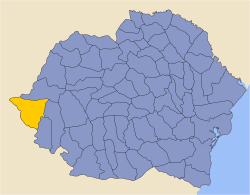|
Timiș-Torontal County
 Timiș-Torontal was a county (Romanian: județ) in the Kingdom of Romania. Its capital was Timișoara. The territory of the county had been transferred to Romania in 1920 from the Kingdom of Hungary under the Treaty of Trianon. GeographyTimiș-Torontal County covered 7,600 km2 and was located in western part of Greater Romania, in the Banat. Currently, the territory that comprised Timiș-Torontal County is now mostly part of Timiș County except for the eastern part, the areas around Lugoj and Făget, which are in Arad County. HistoryOn 27 July 1919, the first prefect of Timiș, appointed by the Royal Romanian authorities, Aurel Cosma, was installed. The Timiş-Torontal County included the parts of the former counties Temes and Torontál which were awarded to the Kingdom of Romania as part of the Banat. The new county was composed, in the first phase, until 1925, the districts (plăși): Buziaş, Centrală (Central), Ciacova, Comloş, Deta, Gătaia, Giulvăz, Jimbolia, Lipova, Periam, Sânnicolaul Mare, and Vinga. On 24 November 1923, there was a border correction between Romania and the Kingdom of Serbs, Croats and Slovenes (the forerunner of Yugoslavia). The villages Jimbolia (Croatian: Žombolj, Hungarian: Zsombolya), Beba Veche (Stara Beba, Óbéba), Cherestur (Krstur, Pusztakeresztúr), Ciortea (Csorda) and Iam (Jám) were ceded to Romania, and Meda (Međa, Párdány), Modoș (Modoš, Módos), Șurian (Šurjan, Surján), Căptălan (Busenje, Káptalanfalva), Crivobara (Markovićevo, Torontálújfalu) and Gaiu Mare (Veliki Gaj, Nagygáj) were handed over to the Kingdom of Serbs, Croats and Slovenes. In 1925 the Law of Administrative Unification was promulgated. The Timiş-Torontal District was divided into two urban communes (Timișoara and Lipova) and 246 rural communes grouped in twelve districts. Subsequently, on 12 December 1926, a thirteenth district was established (Comloş or Comloşul Mare). The county neighbored Caraș County to the southeast, Severin County to the east, Arad County to the north, Kingdom of Yugoslavia to the west and southwest and Hungary to the northwest. In 1929 Timis-Torontal County was integrated into the 7th Ministerial Directorate, led by Sever Bocu.[1] In 1938, Timiş-Torontal, Arad County, Caraș County, Severin County and Hunedoara County were merged into the newly founded Ținutul Timiș. The counties were re-established in the 1940 administrative reform, only for Timiş-Torontal County to be disbanded with the administrative reform of 6 September 1950. Administrative organizationAdministratively, Timiș-Torontal County was originally divided into ten districts (plăși):[2]
Subsequently, three more districts were established:
PopulationAccording to the 1930 census data, the county's population was 499,443, ethnically divided as follows: 37.6% Romanians, 34.9% Germans, 15.4% Hungarians, 5.8% Serbs and Croats, as well as other minorities.[3] From the religious point of view the inhabitants were Roman Catholic (48.6%), Eastern Orthodox (41.1%), Greek Catholic (2.8%), Reformed (2.5%), as well as other minorities.[4] Urban populationIn the year 1930, the urban population of the county (the cities of Timișoara and Lipova) was 97,580 inhabitants, ethnically divided as follows: 30.5% Germans, 29.3% Hungarians, 27.7% Romanians, 7.6% Jews, 2.2% Serbs and Croats, as well as other minorities. From the religious point of view, the urban population consisted of 52.1% Roman Catholic, 27.7% Eastern Orthodox, 9.9% Jewish, 5.0% Reformed, 2.8% Greek Catholic, 2.4% Lutheran, as well as other minorities. References
External linksWikimedia Commons has media related to Interwar Timiș-Torontal County.
|
||||||||||||||||||||||||||||||||||



